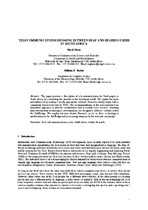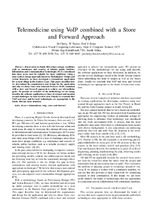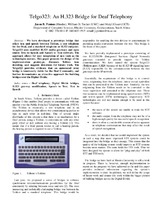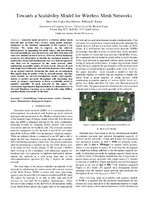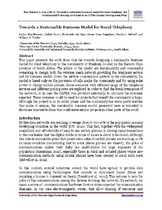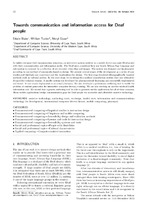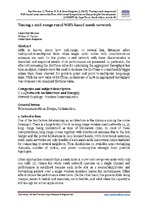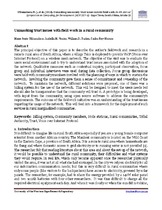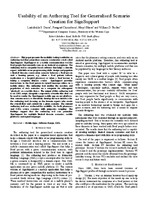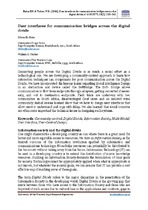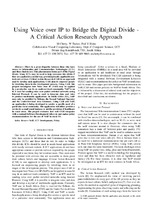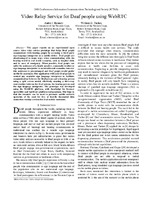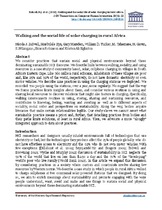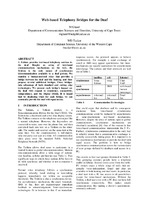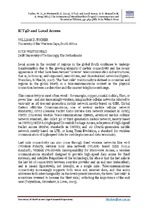Browsing Prof. William Tucker by Title
Now showing items 75-89 of 89
-
Telecommunications bridging between deaf and hearing users in South Africa
(2004)This paper presents a description of telecommunications for Deaf people in South Africa by contrasting the situation in the developed world. We explain the main motivations for providing a locally appropriate solution. ... -
Telemedicine using VoIP combined with a store and forward approach
(Telkom, 2004)Rural areas in South Africa have unique conditions such as remoteness and scarcity of reliable public facilities. Information and Communication Technologies (ICTs) introduced into these areas must be suitable for these ... -
Telgo323: an H.323 Bridge for deaf telephony
(Telkom, 2002)We have developed a prototype bridge that relays text and speech between Teldem, a text telephone for the Deaf, and a standard telephone or H.323 endpoint. Telgo323 uses modified H.323 media gateways and open source Text ... -
Towards a scalability model for wireless mesh networks
(Telkom, 2015)Zenzeleni mesh network is a wireless ad-hoc mesh network that provides voice services using public analogue telephones to the Mankosi community in the Eastern Cape Province. We would like to improve on the network ... -
Towards a sustainable business model for rural telephony
(Telkom, 2012)This paper presents the work done thus far towards designing a sustainable business model for rural telephony in the community of Mankosi, located in the Eastern Cape province of South Africa. The pillars of the model are ... -
Towards communication and information access for deaf people
(SAICSIT, 2014)In tightly circumscribed communication situations, an interactive system resident on a mobile device can assist Deaf people with their communication and information needs. The Deaf users considered here use South African ... -
Tuning a mid-range rural WiFi-based mesh network
(ACM, 2013)Little is known about how mid-range, or several km, dis- tances a ect multipoint-to-multipoint links when single ra- dio nodes with omnidirectional antennas are used. In this poster, a real network with these characteristics ... -
Unmasking community trust issues in rural field work
(ACM, 2013)The principal objective of this paper is to describe the au thor's fieldwork and research in a remote rural area of South Africa, where a Village Telco is deployed to provide Voice over Internet Protocol on a wireless mesh ... -
Usability of an authoring tool for generalised scenario creation for signsupport
(Telkom, 2015)This paper presents the usability testing results for an authoring tool that generalises scenario creation for a tool called SignSupport. SignSupport is a mobile communication tool for Deaf people that currently runs ... -
User interfaces for communication bridges across the digital divide
(Springer-Verlag, 2006)Connecting people across the Digital Divide is as much a social effort as a technological one. We are developing a community-centred approach to learn how interaction techniques can compensate for poor communication across ... -
Using voice over IP to bridge the digital divide: a critical action research approach
(Telkom, 2003)There is a great disparity between those who have access to Information and Communication Technologies (ICTs) and those that do not. This phenomenon forms part of the Digital Divide. Many ICTs may be used to help overcome ... -
Video Relay Service for Deaf people using WebRTC
(University of the Western Cape, 2019-03)This paper reports on an experimental open source video relay service prototype that helps Deaf people communicate with hearing people by accessing a third party sign language interpreter on a mobile device. Deaf people ... -
Walking and the social life of solar charging in rural Africa
(Association for Computing Machinery, 2013)We consider practices that sustain social and physical environments beyond those dominating sustainable HCI discourse. We describe links between walking, sociality, and using resources in a case study of community-based, ... -
Web-based telephony bridges for the deaf
(Telkom, 2001)A Teldem provides text-based telephony services to the deaf. Despite an array of text-based communications mechanisms on the web, the Teldem is the only means of synchronous telecommunication available to a deaf person. ... -
Untitled
(John Wiley & Sons, 2015)Local access in the context of regions in the global South continues to undergo transformation due to the growing ubiquity of mobile connectivity and the recent appearance of what have been termed “inverse” telecommunication ...

